WNC History: The wild ride of Asheville streetcars, 1889-1934
by Anne Chesky
“One toddler joined a line of folks waiting for the trolley far out on Montford Avenue, and when the car stopped to pick them up, a chivalrous gentleman, assuming the child’s mother was somewhere in the crowd, lifted the kid up the steps and deposited him onboard,” wrote Asheville Citizen-Times columnist Bob Terrell in 2007.
Terrell had written the column based on a conversation with Edwin White, who had been the chief dispatcher of Asheville’s trolley system for many years.
Terrell continued: “The child strolled by the conductor and climbed into a seat. At the end of the run, the boy was the only passenger left aboard. ”The trolley conductor delivered the child to Edwin White at the trolley terminus, the same place he had delivered other lost items throughout the years – some expected: jewelry, hats, purses, umbrellas and some unexpected: false teeth (removed to ease the discomfort from the jostling trolley ride and forgotten on the rattan seats); a wallet containing a Ku Klux Klan membership receipt (which went unclaimed); a case laden with 12 quarts of moonshine (which was later claimed); and, apparently, children.
The lost toddler’s parents, after frantically searching the neighborhood, finally called the police, only to find that their child was already at the station playing with the officers.
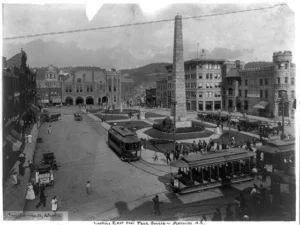
First run
Asheville’s electric streetcar system was the first of its kind in North Carolina — and only the second such system in the South — so when the shiny yellow trolleys made their debut, Asheville’s residents were understandably excited. Now, for a nickel (the equivalent of a little over $1.50 today), folks could consistently and much more quickly navigate the city’s streets in relative comfort.
On Feb. 6, 1889, surrounded by a crowd of people, the trolley system’s contractor, E.D. Davidson climbed on board to take the first car on its maiden voyage.
A group of Asheville women wearing their best dresses waited to be among the first passengers. Davidson turned them away, explaining that only men would be allowed in the cars — just in case something went wrong on the trolley’s first run. The women could ride later in the day. One of the women wanted to ride so badly, she yelled at Davidson, “I don’t care if it ends up in the French Broad River.”
At noon exactly, the city’s three cars began their trial run.
As the first car rumbled along the tracks, the crowd followed, applauding its progress. One man shouted as the trolley outpaced the crowd, “Well, it’s gone, but I don’t believe it.”
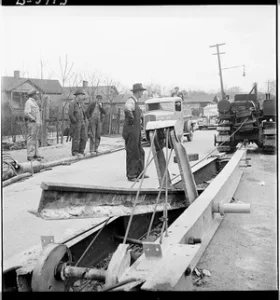
After making it safely to the depot, the passengers — Asheville’s mayor, city council members, and other of the city’s more distinguished men — disembarked for a ceremonial meal. When the trolleys began their return trip, a team of horses was hitched to one of the cars to demonstrate the vast difference between horsepower and electric power. The electric streetcar ascended easily, stopping frequently for the passengers to “laugh at their less fortunate companions, who were laboring slowly along, far in the rear.” The trip by streetcar took just 10 minutes.
The following week, Asheville was home to another N.C. electrical first: the first newspaper printed in N.C. by an electric motor — supplied by the same company responsible for powering the streetcars.
By the end of the year, the city had added additional cars and more routes, eventually transitioning from only operating during daylight hours to offering around the clock service. The thriving streetcar system buoyed Asheville’s reputation as a progressive city. The population boomed along with the city’s economy.
Though the novelty of the system wore off, the trolleys became central to city dwellers’ lives. By 1907, ridership was at an all-time high, with more than three million rides taken annually. Eight years later, the city operated 43 streetcars. Passengers could travel by trolley as far as Weaverville and West Asheville.
Trouble ahead
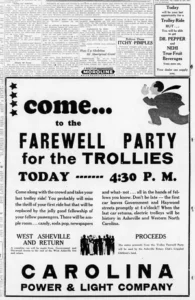
It was not always smooth sailing, however.
In 1894, car No. 1 began the steep descent to the depot. When the car began increasing in speed; the conductor braked, but rather than slow, the wheels began to slide. The car continued to accelerate until reaching a curve on Depot Street, first tilting onto two wheels, then toppling onto its side. Bystanders rushed to help passengers out of the car; a number of people were gravely injured, but none fatally. Other trolley accidents occurred over the years; including at least one head-on collision that killed a conductor.
Then, in 1913, the trolley system ceased operation for a week while conductors went on strike for better wages. According to the Marion Progress, when the trolley company brought in outside help to try to keep the trolleys running, 2,000 Asheville men gathered in protest and forced the strike-breakers to leave town. N.C.’s governor intervened, promising militia action if necessary. The following day the trolley company conceded to some of the worker’s demands; the minimum wage was raised by a penny – from 18 to 19 cents an hour. The trolleys began operating again. In 1926, workers again struck for better wages, again paralyzing the city for several days.
And, though the trolley system served everyone, it did not do so equally. Like the rest of Asheville, the streetcars were segregated. In a 1981 interview, Floyd Bixler McKissick, who was born in Asheville in 1922, described one of his earliest memories: “When I was about four, I ran ahead of my aunt to board an Asheville streetcar and join a group of white boys watching the conductor demonstrate how he operated the controls. The conductor shouted at me to get to the back of the streetcar where I belonged, and the boys took up the taunt. When my aunt reached the street car, the conductor upbraided her for not teaching me my place.”
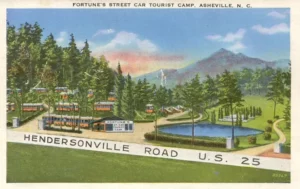
End of the line
Eventually, as buses and personal automobiles became more popular and more affordable, the ridership on Asheville’s trolleys declined; and the system quickly became obsolete. Like those first trolley rides in 1889, Asheville’s last trolley rides on Sept. 7, 1934 were held with a similar sense of ceremony. Fares were waived; any donations were gathered to support the fight against polio.
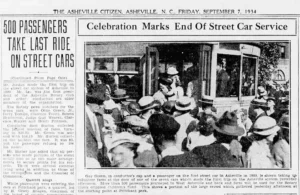
The Asheville Citizen wrote of the trolleys’ final run, “Although the general motif was gay, there was an undercurrent of sadness among many of the passengers at the passing of the familiar streetcars which had served the city so long.”
Asheville’s streetcar tracks were paved over and then removed in 1942 to provide metal for the war effort. As for the streetcars themselves, many were repurposed. Several went on to become cabins at Fortune’s Street Car Tourist Camp on Hendersonville Road, which operated at least throughout the mid-1930s. And, for more than 50 years, two of the retired cars were used for storage at Steve’s Cleaners in Spindale.
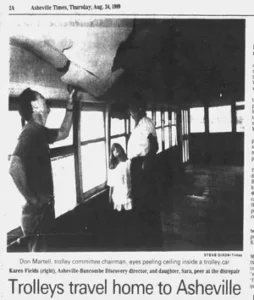
Then, in 1989 – 100 years after Asheville’s first trolleys began their routes – a group raised more than $20,000 to purchase the trolleys and bring them back to Asheville. The rusty trolleys were placed in Pack Square for public viewing before being stored for renovation and repair.
Today, a restored car built in 1927 – Car 119 – occasionally still takes passengers on the Craggy Mountain Line in North Asheville.
Read at Asheville Citizen Times
Anne Chesky is the executive director of the Asheville Museum of History.
